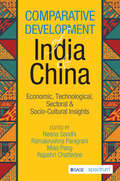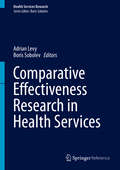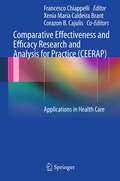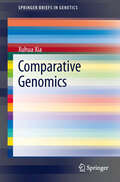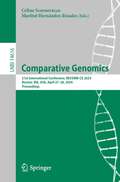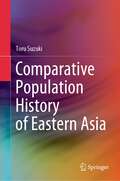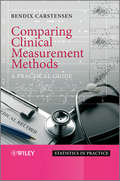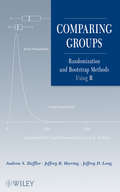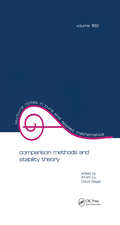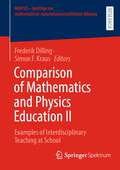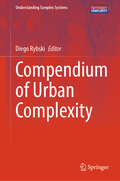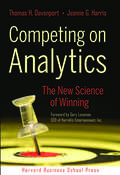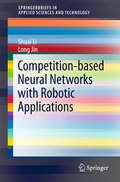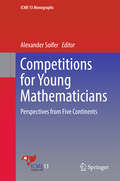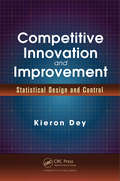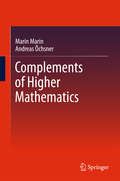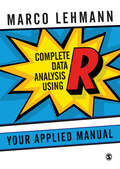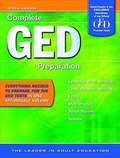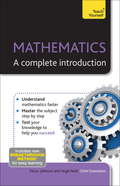- Table View
- List View
Comparative Development of India & China: Economic, Technological, Sectoral & Socio-cultural Insights
by Neena Sondhi Ramakrushna Panigrahi Miao Pang Rajashri ChatterjeeThe prodigious economic growth of India and China over the last three decades has ensured their rightful prominence in the global economic order. The two players opened up their respective economies to liberalization and market regulations, which led to a tectonic shift from agriculture-based economies to manufacturing and service-based economies. In this context, Comparative Development of India and China offers contemporary research on economic, technological, sectoral and sociocultural issues by highlighting the opportunities as well as vulnerabilities in the development of the two fastest growing nations in the world. It unveils the similarities of thought and practices, and explores the plethora of possibilities for collaborative effort that may serve to contribute to the prosperity and progress of both the countries. The perspectives presented by various Indian and Chinese scholars in this edited volume provide varied outlooks and insights on these two nations, albeit within a single thematic framework.
Comparative Effectiveness Research in Health Services (Health Services Research)
by Boris Sobolev Adrian LevyThe second volume in the Health Services Research series provides a series of perspectives on comparative effectiveness research. Motivated by concern from the general public, governments in virtually all countries with developed and rapidly developing economies have been actively seeking and promoting ways of improving the patient experience of health care, improving the health of populations, and reducing the per capita cost of health care. While comparing treatment outcomes is not a new concept, appreciation of its potential application has grown in recent years. In addition to traditional health sciences methods, modern approaches to comparative effectiveness research now include greater emphasis on social sciences frameworks such as economics, ethics, and implementation science. Moreover, a key feature of the modern approach to comparing treatment outcomes is a focus on the individual patient through explicit consideration of inter-patient variability and patient-reported outcomes. Comparative Effectiveness Research presents a series of chapters of relevance including introductions to areas that are being incorporated when comparing treatments, country-specific applications, patient-centred approaches, and modern methods. Included are chapters on the following areas that are being considered in treatment comparisons: ethics, economics and costs, implementation science, modern payment schemes (coverage with evidence development), and priority setting. Country-specific examples include an overview chapter on national approaches from various countries in Europe, Australia, and Canada, as well as specific chapters on comparative effectiveness research in Brazil and in the United States. The focus on the individual patient is described through chapters on patient-centred comparative effectiveness research, individualized treatment, the link with personalized medicine, and incorporating patient and public input for treatment. Methodological chapters include overviews of data sources, study designs, new statistical methods of combining results, the link with evidence-based medicine, specific issues when comparing drug and non-drug technologies, and dissemination of results.
Comparative Effectiveness and Efficacy Research and Analysis for Practice (CEERAP): Applications in Health Care
by Francesco Chiappelli Xenia Maria Caldeira Brant Corazon B. CajulisRecent trends in health care across the United States and internationally have emphasized a novel approach that consists in comparing the effectiveness and efficacy of treatment interventions with a patient-centered emphasis (i.e., evidence-based health care), while ensuring cost constraints, maximizing benefits, and minimizing risks. In this book, experts in comparative effectiveness and efficacy research and analysis for practice (CEERAP) in health care in general address a range of topical issues. The emphasis is on implications for endodontics and nursing, both of which are considered in a series of detailed chapters. Commonalities and differences among CEERAP, utility-based and logic-based analysis and decision-making, and evidence-based and patient-centered practice are defined and discussed. The book concludes by examining applications for CEERAP in developing patient-centered optimal treatment interventions for the next decade.
Comparative Genomics (SpringerBriefs in Genetics)
by Xuhua XiaThis book provides an evolutionary conceptual framework for comparative genomics, with the ultimate objective of understanding the loss and gain of genes during evolution, the interactions among gene products, and the relationship between genotype, phenotype and the environment. The many examples in the book have been carefully chosen from primary research literature based on two criteria: their biological insight and their pedagogical merit. The phylogeny-based comparative methods, involving both continuous and discrete variables, often represent a stumbling block for many students entering the field of comparative genomics. They are numerically illustrated and explained in great detail. The book is intended for researchers new to the field, i.e., advanced undergraduate students, postgraduates and postdoctoral fellows, although professional researchers who are not in the area of comparative genomics will also find the book informative.
Comparative Genomics: 21st International Conference, RECOMB-CG 2024, Boston, MA, USA, April 27–28, 2024, Proceedings (Lecture Notes in Computer Science #14616)
by Celine Scornavacca Maribel Hernández-RosalesThis book constitutes the proceedings of the 21st International Conference on Comparative Genomics, RECOMB-CG 2024, which was held in Boston, MA, USA, during April 27–28, 2024. The 13 full papers presented in this book were carefully reviewed and selected from 21 submissions. The papers are divided into the following topical sections: phylogenetic networks; homology and phylogenetic reconstruction; tools for evolution reconstruction; genome rearrangements; and genome evolution.
Comparative Population History of Eastern Asia
by Toru SuzukiThis book compares the population history of Japan, Korea, Taiwan, and China to understand such emergent changes as extremely low fertility in Korea and Taiwan, compressed urbanization and a massive diaspora from Korea, early population aging relative to economic development in China, and changing patterns of cross-border migration in the region. After discussing the origin of each ethnic group, premodern population changes are examined by reviewing historical demographic studies including those written in local languages. A new population estimation for premodern Korea is also presented. Topics covered in this book include population growth, fertility, mortality, domestic and cross-border migration, marriage, divorce, and households. Contrasts between economic and population giants (China and Japan), former Japanese colonies (Korea and Taiwan), feudalism and Confucianism (Japan and others), and capitalism and socialism of the same ethnic groups (South and North Korea, Taiwan, and China) provide a fresh view of population dynamics in relation to political, economic, and cultural changes. The population study of Eastern Asia has great importance. If economic development is checked by early and rapid aging, it functions to preserve the conventional Euro-centric world system and Pax Americana. On the other hand, if China succeeds in further development while sustaining a socialist dictatorship, it is a challenge to the authority of liberal democracy. If the institution of marriage remains robust and extramarital births do not increase in Eastern Asia, it implies that an aspect of family change is culturally dependent. This book provides clues to help answer such important questions.
Comparing Clinical Measurement Methods
by Bendix CarstensenThis book provides a practical guide to analysis of simple and complex method comparison data, using Stata, SAS and R. It takes the classical Limits of Agreement as a starting point, and presents it in a proper statistical framework. The model serves as a reference for reporting sources of variation and for providing conversion equations and plots between methods for practical use, including prediction uncertainty.Presents a modeling framework for analysis of data and reporting of results from comparing measurements from different clinical centers and/or different methods.Provides the practical tools for analyzing method comparison studies along with guidance on what to report and how to plan comparison studies and advice on appropriate software.Illustrated throughout with computer examples in R.Supported by a supplementary website hosting an R-package that performs the major part of the analyses needed in the area.Examples in SAS and Stata for the most common situations are also provided.Written by an acknowledged expert on the subject, with a long standing experience as a biostatistician in a clinical environment and a track record of delivering training on the subject.Biostatisticians, clinicians, medical researchers and practitioners involved in research and analysis of measurement methods and laboratory investigations will benefit from this book. Students of statistics, biostatistics, and the chemical sciences will also find this book useful.
Comparing Groups
by Jeffrey R. Harring Jeffrey D. Long Andrew S. ZiefflerA hands-on guide to using R to carry out key statisticalpractices in educational and behavioral sciencesresearch Computing has become an essential part of the day-to-daypractice of statistical work, broadening the types of questionsthat can now be addressed by research scientists applying newlyderived data analytic techniques. Comparing Groups:Randomization and Bootstrap Methods Using R emphasizes thedirect link between scientific research questions and dataanalysis. Rather than relying on mathematical calculations, thisbook focus on conceptual explanations and the use of statisticalcomputing in an effort to guide readers through the integration ofdesign, statistical methodology, and computation to answer specificresearch questions regarding group differences.Utilizing the widely-used, freely accessible R software, theauthors introduce a modern approach to promote methods that providea more complete understanding of statistical concepts. Following anintroduction to R, each chapter is driven by a research question,and empirical data analysis is used to provide answers to thatquestion. These examples are data-driven inquiries that promoteinteraction between statistical methods and ideas and computerapplication. Computer code and output are interwoven in the book toillustrate exactly how each analysis is carried out and how outputis interpreted. Additional topical coverage includes:Data exploration of one variable and multivariate dataComparing two groups and many groupsPermutation tests, randomization tests, and the independentsamples t-TestBootstrap tests and bootstrap intervalsInterval estimates and effect sizesThroughout the book, the authors incorporate data fromreal-world research studies as well aschapter problems that providea platform to perform data analyses. A related Web site features acomplete collection of the book's datasets along with theaccompanying codebooks and the R script files and commands,allowing readers to reproduce the presented output and plots.Comparing Groups: Randomization and Bootstrap Methods UsingR is an excellent book for upper-undergraduate and graduatelevel courses on statistical methods, particularlyin theeducational and behavioral sciences. The book also serves as avaluable resource for researchers who need a practical guide tomodern data analytic and computational methods.
Comparing and Scaling, Ratio, Proportion, and Percent
by Glenda Lappan James T. Fey William M. Fitzgerald Susan N. Friel Elizabeth Difanis PhillipsNIMAC-sourced textbook
Comparing and Scaling: Ratio, Proportion, and Percent (Texas)
by Glenda Lappan James T. Fey William M. Fitzgerald Susan N. Friel Elizabeth Difanis Phillips Michelle BarberaNIMAC-sourced textbook
Comparing and Scaling: Ratios, Rates, Percents, and Proportions (Connected Mathematics)
by Glenda Lappan James T. Fey Susan N. Friel Elizabeth Difanis PhillipsThe contents of the book include: Ways of Comparing: Ratios and Proportions, Comparing and Scaling Rates, Markups, Markdowns, and Measures: Using Ratios, Percents, and Proportions, English/Spanish Glossary, etc.
Comparison Methods and Stability Theory
by Xinzhi LiuThis work is based on the International Symposium on Comparison Methods and Stability Theory held in Waterloo, Ontario, Canada. It presents advances in comparison methods and stability theory in a wide range of nonlinear problems, covering a variety of topics such as ordinary, functional, impulsive, integro-, partial, and uncertain differential equations.
Comparison of Mathematics and Physics Education II: Examples of Interdisciplinary Teaching at School (MINTUS – Beiträge zur mathematisch-naturwissenschaftlichen Bildung)
by Frederik Dilling Simon F. KrausInterdisciplinary teaching is considered as one of the main goals of education worldwide. At the same time, it poses an immense challenge to teachers who have been trained in only one of the combines subjects. This is true even for closely related disciplines such as mathematics and physics. In this volume, practice-oriented educational comparisons are made across various topics that are highly relevant in both subjects. Furthermore, practical examples are presented in the form of lesson plans in which exemplary implementation in class is presented, considering both educational perspectives.
Compendium of Urban Complexity (Understanding Complex Systems)
by Diego RybskiThis book brings together key findings, insights, and theories at the intersection of two disciplines – city science and complex systems. It features a curated collection of chapters contributed by emerging scholars conducting cutting-edge research in complexity science, interdisciplinary physics, and quantitative geography. The compendium is tailored to a thematically diverse audience, spanning quantitative fields such as statistical and mathematical physics, as well as socially-focused domains such as geography and urban planning. By integrating novel methods and insights from physics, economics, and geography, this book aims at an interdisciplinary spectrum of graduate students and academic researchers studying cities as complex systems.
Competition-Based Neural Networks with Robotic Applications (SpringerBriefs in Applied Sciences and Technology)
by Shuai Li Long JinFocused on solving competition-based problems, this book designs, proposes, develops, analyzes and simulates various neural network models depicted in centralized and distributed manners. Specifically, it defines four different classes of centralized models for investigating the resultant competition in a group of multiple agents. With regard to distributed competition with limited communication among agents, the book presents the first distributed WTA (Winners Take All) protocol, which it subsequently extends to the distributed coordination control of multiple robots. Illustrations, tables, and various simulative examples, as well as a healthy mix of plain and professional language, are used to explain the concepts and complex principles involved. Thus, the book provides readers in neurocomputing and robotics with a deeper understanding of the neural network approach to competition-based problem-solving, offers them an accessible introduction to modeling technology and the distributed coordination control of redundant robots, and equips them to use these technologies and approaches to solve concrete scientific and engineering problems.
Competition: The Birth of a New Science
by James CaseThe Mathematical Theory of Games Sheds Light On A Wide Range of Competitive ActivitiesWhat do chess-playing computer programs, biological evolution, competitive sports, gambling, alternative voting systems, public auctions, corporate globalization, and class warfare have in common? All are manifestations of a new paradigm in scientific thinking, which James Case calls "the emerging science of competition." Drawing in part on the pioneering work of mathematicians such as John von Neumann, John Nash (of A BeautifulMind fame), and Robert Axelrod, Case explores the common game-theoretical strands that tie these seemingly unrelated fields together, showing how each can be better understood in the shared light of the others. Not since James Gleick's bestselling book Chaos brought widespread public attention to the new sciences of chaos and complexity has a general-interest science book served such an eye-opening purpose. Competition will appeal to a wide range of readers, from policy wonks and futurologists to former jocks and other ordinary citizens seeking to make sense of a host of novel—and frequently controversial—issues.
Competitions for Young Mathematicians: Perspectives from Five Continents (ICME-13 Monographs)
by Alexander SoiferThis book gathers the best presentations from the Topic Study Group 30: Mathematics Competitions at ICME-13 in Hamburg, and some from related groups, focusing on the field of working with gifted students. Each of the chapters includes not only original ideas, but also original mathematical problems and their solutions. The book is a valuable resource for researchers in mathematics education, secondary and college mathematics teachers around the globe as well as their gifted students.
Competitive Innovation and Improvement: Statistical Design and Control
by Kieron DeyCompetitive Innovation and Improvement: Statistical Design and Control explains how to combine two widely known statistical methods‘statistical design and statistical control in a manner that can solve any business, government, or research problem quickly with sustained results. Because the problem-solving strategy employed is pure scientific metho
Complements of Higher Mathematics
by Andreas Öchsner Marin MarinThis book highlights the remarkable importance of special functions, operational calculus, and variational methods. A considerable portion of the book is dedicated to second-order partial differential equations, as they offer mathematical models of various phenomena in physics and engineering. The book provides students and researchers with essential help on key mathematical topics, which are applied to a range of practical problems. These topics were chosen because, after teaching university courses for many years, the authors have found them to be essential, especially in the contexts of technology, engineering and economics. Given the diversity topics included in the book, the presentation of each is limited to the basic notions and results of the respective mathematical domain. Chapter 1 is devoted to complex functions. Here, much emphasis is placed on the theory of holomorphic functions, which facilitate the understanding of the role that the theory of functions of a complex variable plays in mathematical physics, especially in the modeling of plane problems. In addition, the book demonstrates the importance of the theories of special functions, operational calculus, and variational calculus. In the last chapter, the authors discuss the basic elements of one of the most modern areas of mathematics, namely the theory of optimal control.
Complete Data Analysis Using R: Your Applied Manual
by Marco LehmannThis step-by-step guide shows you how to use R to get data analysis right. The book explores the entire process of analysis, covering key steps from preparing your data to putting your analysis together and writing up your findings. It helps you get to grips with doing different statistical techniques in R and: Equips you with practical data visualisation tools to create graphs and tables. Shows you how to prepare and present your research for assessment, publication and dissemination. Covers key issues facing today’s social scientists, such as making research reproducible. Features include an introduction to each chapter, and end-of-chapter exercises to check your understanding of the material. The online resources for this text include data sets that you can perform your own analysis on, and links to publications that are relevant to programming with R. A good starting point for any postgraduate student conducting a research project, this book will help you develop your statistics and programming knowledge and get quickly up to speed.
Complete Data Analysis Using R: Your Applied Manual
by Marco LehmannThis step-by-step guide shows you how to use R to get data analysis right. The book explores the entire process of analysis, covering key steps from preparing your data to putting your analysis together and writing up your findings. It helps you get to grips with doing different statistical techniques in R and: Equips you with practical data visualisation tools to create graphs and tables. Shows you how to prepare and present your research for assessment, publication and dissemination. Covers key issues facing today’s social scientists, such as making research reproducible. Features include an introduction to each chapter, and end-of-chapter exercises to check your understanding of the material. The online resources for this text include data sets that you can perform your own analysis on, and links to publications that are relevant to programming with R. A good starting point for any postgraduate student conducting a research project, this book will help you develop your statistics and programming knowledge and get quickly up to speed.
Complete GED Preparation
by Steck-Vaughn Steck-Vaughn CompanyReviews math, social studies, science, and reading and writing skills, and provides sample tests with answers explained.
Complete Mathematics: A step by step introduction to the mathematical essentials
by Hugh Neill Trevor JohnsonAre you looking for a clear, accessible guide to mathematics that can help you brush up your skills and rediscover the key concepts and techniques? Complete Mathematics provides an invaluable, step-by-step introduction to the subject. Packed full of worked examples and useful exercises, it will guide you through the essentials quickly and easily, giving you the knowledge you need to gain maths confidence.NOT GOT MUCH TIME?One, five and ten-minute introductions to key principles to get you started.AUTHOR INSIGHTSLots of instant help with common problems and quick tips for success, based on the author's many years of experience.TEST YOURSELFTests in the book and online to keep track of your progress.EXTEND YOUR KNOWLEDGEExtra online articles at www.teachyourself.com to give you a richer understanding of psychology.FIVE THINGS TO REMEMBERQuick refreshers to help you remember the key facts.TRY THISInnovative exercises illustrate what you've learnt and how to use it.
Complete Mathematics: A step by step introduction to the mathematical essentials
by Trevor Hugh NeillAre you looking for a clear, accessible guide to mathematics that can help you brush up your skills and rediscover the key concepts and techniques? Complete Mathematics provides an invaluable, step-by-step introduction to the subject. Packed full of worked examples and useful exercises, it will guide you through the essentials quickly and easily, giving you the knowledge you need to gain maths confidence.NOT GOT MUCH TIME?One, five and ten-minute introductions to key principles to get you started.AUTHOR INSIGHTSLots of instant help with common problems and quick tips for success, based on the author's many years of experience.TEST YOURSELFTests in the book and online to keep track of your progress.EXTEND YOUR KNOWLEDGEExtra online articles at www.teachyourself.com to give you a richer understanding of psychology.FIVE THINGS TO REMEMBERQuick refreshers to help you remember the key facts.TRY THISInnovative exercises illustrate what you've learnt and how to use it.
